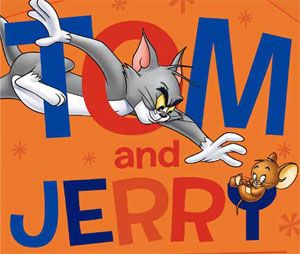There are three phases of Tom and Jerry cartoons. First are the wonderful 1940's and 50's MGM cartoons, which were colored in beautiful blue and grey pastel tones. Here, the classic chase of "cat and mouse" occurred in just about every way conceivable. It is no doubt that the creative minds at MGM's animation division may have been inspired by being located on MGM's lot #2, and perhaps channeled some of Andy Hardy's hoodoo, due to the fact that the street used for filming was located directly behind the animatinion studio. In these shorts, when Tom gets injured while chasing Jerry or gets cornered by Spike the bulldog, he let out a satisfyingly comical yelping yowl different than Walt Disney's "Goofy" yell: "Waa-hoo-hoo-hooey!" in sound, but equally iconic with hilarity. These cartoons were created during the Fred Quimby years; he produced Tom and Jerry along with all other MGM cartoons until the animation division was closed in 1957. The famous animation team William Hanna and Joe Barbera were in charge of animating Tom and Jerry for almost their entire run at MGM before forming their own successful animation company know as what else, "Hanna-Barbera." Continued after the jump:
Tom and Jerry's second phase occurred when the cartoon series was briefly resurrected in 1961, transforming into super-weird cartoons that actually frightened or at least puzzled their audience. Cheaply produced using "limited-animation," these stories often feature Tom being brutally beaten by a man with bloodshot eyes, so full of rage that he could only mutter. Only thirteen of these bizarre Tom and Jerry cartoons were made between the years 1961 and 1962 by Rembrandt Films in Czechoslovakia led by Gene Deitch. Perhaps being animated in Czechoslovakia is enough of an excuse to explain away the strangeness, the echoing music and sound effects, and the bizarre behavior of Tom & Jerry. If these cartoons had been done a little later, psychedelic drugs would certainly be the culprit.
Tom and Jerry's third and final phase began in 1963 when MGM resurrected the golden cartoon team of Tom and Jerry, and offered veteran animator Chuck Jones full creative control over the franchise if he would oversee the project. Jones had just been excised from the Warner Brothers animation department after a long career at the studio, where he had created Michigan J. Frog, Pepe' Le Pew, the Road Runner and Wile E. Coyote. Jones jumped at the chance to helm a lavishly funded animation project at MGM, avoiding involvement in cheaply produced, more common cartoons with tiny bits of animation and tons of dialogue called "limited animation," or, in his dismissive words, "illustrated radio."
Jones took over Tom and Jerry for MGM and updated the look of the franchise, transforming the well-known cat and mouse characters into ones with exaggerated 1960's-style eyelashes, found most certainly on his later character designs for the "The Grinch Who Stole Christmas" cartoon special. Tom most notably received heavy expressive eyebrows, and Jerry was enhanced with giant rounded ears. Tom replaced the MGM lion in the memorable new opening credits, meowing and hissing.
Mel Blanc, voice of Bugs Bunny and numerous other legendary cartoon characters has a very distinctive voice. Obviously, Chuck Jones brought Blanc to voice the occasional Tom and Jerry yelps or moans because of their long shared tenure at Warner Brothers. Unfortunately, when Blanc isn't doing Bugs Bunny or one of his other trademark voices, he just sounds like...Mel Blanc. The same holds true for Blanc's voice-over stint on TV's late 1970's awesome stink-a-thon, Buck Rogers in the 25th Century, where he voiced the impish wiener-headed robot, "Twiki."
This two-DVD set features all of the Chuck Jones Tom and Jerry shorts, 34 in total. There is text on the back of the DVD box that warns viewers that the collection is for the adult consumer, and might not be suitable for children. This addresses the age-old issue of violence in cartoons, not the racist depictions sometimes found in Tom and Jerry shorts of the 40's and 50's. The warning also indicates that the shorts will be uncut and restored, with the original content included, not just a compilation for the kiddies.
Most importantly, this disc includes one of the best documentaries we have seen in a long time called Chuck Jones: Memories of a Childhood. This documentary captures Chuck Jones later in his life recalling tales of his hard yet fascinating childhood. His charm and genius wins you over immediately, teaching anyone who watches it that he was truly something magical, not only as an animator or animation producer, but also perhaps as an American "Gandalf the Grey" or "Merlin." His personality is infectious, it makes me wish I had known him, or could simply see more footage of him just talking.
Another documentary is included which tells the history of Tom and Jerry, called Tom and Jerry...and Chuck, which tells the tale of the history of Tom and Jerry leading up to Chuck Jones' involvement. Tom and Jerry - The Chuck Jones Edition is a must have for any fans of animation, and certainly for fans of Tom and Jerry. I would buy the excellent Chuck Jones: Memories of a Childhood alone. It was so good, and we watched it twice in a row. Congratulations to producers Peggy Stern, Joseph Kennedy and animation guru John Canemaker for giving us such a charming and unique glimpse at Mr. Chuck Jones, who was truly American treasure.



.jpg)
.jpg)